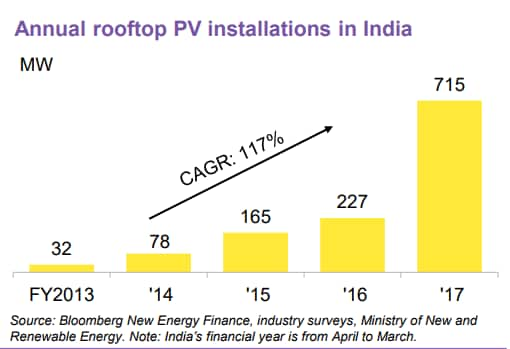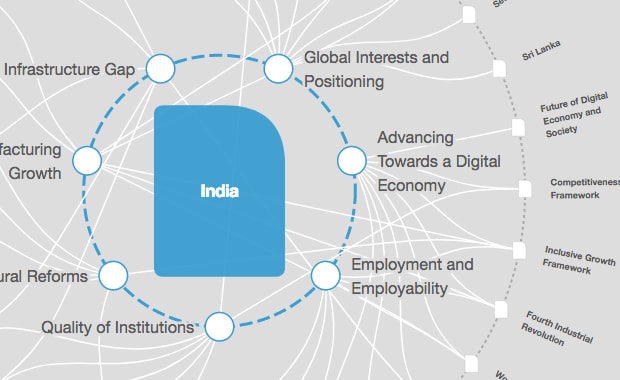India added more rooftop solar power last year than the previous 4 years combined

Image: REUTERS/Amit Dave

Get involved with our crowdsourced digital platform to deliver impact at scale
Stay up to date:
India
India increased its rooftop solar power capacity in 2017 by more than the previous four years combined, according to a new report from Bloomberg New Energy Finance. The country added 715 megawatts in rooftop photovoltaic (PV) power in 2017, contributing to a compound annual growth rate of 117% since 2013.
The expansion has gone hand in hand with a steady decline in the price of rooftop solar panels. Prices have been cut in half over the past five years, thanks to mass production, fierce competition and advances in technology. In contrast, average retail electricity prices have increased by 22% during the same period.

Solar rooftop panels are the fastest growing sub-sector of the renewables market in India. But the wider market is also showing some impressive growth.
Installation of renewable energy projects will be higher than fossil fuel technologies for the first time in 2017, and is projected to be so for the years ahead. In total, the country added 12 gigawatts of renewable energy plants in the last financial year (from April 2016 to March 2017), representing 66% growth on the previous year.

Rural electrification is a key part of the Indian government's plan to boost the economy. About 300 million of India's 1.3 billion people are still not connected to the electricity distribution grid.
Kerosene lamps are commonly used in the rural locations, and these are bad for the environment as well as being hazardous around the home.
Prime Minister Narendra Modi has promised to meet these electrification goals by installing record amounts of renewable energy.

In 2014, Modi set a target to increase India's solar power capacity to 100 gigawatts by 2022 – 40% of which is to be from rooftop solar. So despite the fast expansion, there is still a great deal of capacity to add before that target is achieved.
But even aiming for such ambitious targets will undoubtedly contribute to the world’s efforts to meet the goals set by the Paris climate agreement, and possibly inspire other countries to start solar power revolutions of their own.
Don't miss any update on this topic
Create a free account and access your personalized content collection with our latest publications and analyses.
License and Republishing
World Economic Forum articles may be republished in accordance with the Creative Commons Attribution-NonCommercial-NoDerivatives 4.0 International Public License, and in accordance with our Terms of Use.
The views expressed in this article are those of the author alone and not the World Economic Forum.
The Agenda Weekly
A weekly update of the most important issues driving the global agenda
You can unsubscribe at any time using the link in our emails. For more details, review our privacy policy.
More on IndiaSee all
Apurv Chhavi
April 18, 2024
Victoria Masterson
March 20, 2024
Reuters
February 28, 2024
Shakthi Nagappan
February 13, 2024
Priya Singh
February 8, 2024
Thomas Kerr
February 5, 2024






